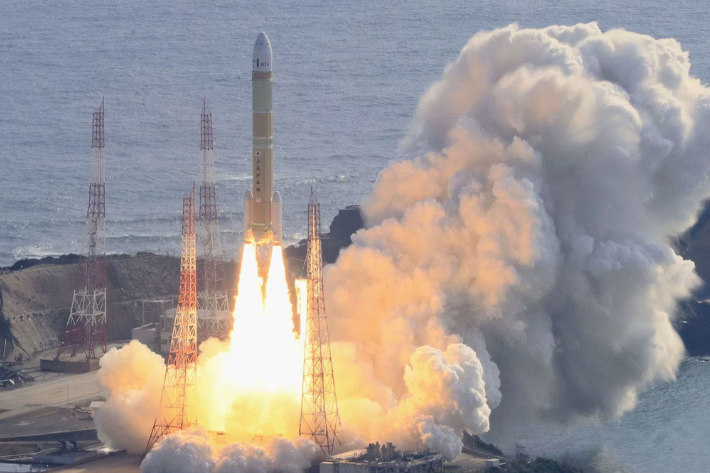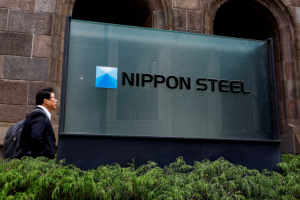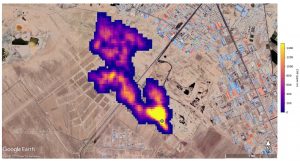Japan successfully launched its new H3 flagship rocket on Saturday, a year after the vehicle’s inaugural flight ended in failure last year.
The launch helps Japan put its space programme back on track after multiple setbacks.
It also marks a second straight win for the Japan Aerospace Exploration Agency (JAXA) after its lunar lander, SLIM, achieved a “pinpoint” touchdown last month and made Japan only the fifth country to put a spacecraft on the moon.
Also on AF: Google Set to Launch Satellite to Pinpoint Methane Emission Sites
A relatively small player in space by number of launches, Japan is seeking to revitalise its programme as it partners with ally the United States to counter China.
The H3 lifted off at 9:22 am local time (0022 GMT) and after it successfully released a small satellite, jubilant scientists at the Tanegashima Space Center in southern Japan clapped, yelled and hugged each other.
The rocket also released a microsatellite and a dummy satellite during its flight of nearly two hours.
“The newborn H3 has just made its first cry”, JAXA project manager Masashi Okada, who has led the decade-long development of the new rocket, told a news conference.
“And we need to start preparing for the third H3 launch as soon as tomorrow.”
The H3 is due to replace the two-decade-old H-IIA, which is retiring after two more launches. Another failed flight would have seen Japan face the prospect of losing independent access to space.
‘Fielding inquiries from around the world’
The H3’s first launch in March ended up with ground control destroying the rocket 14 minutes after liftoff when the second-stage engine failed to ignite. JAXA listed three possible electrical faults in a review released in October but could not identify the direct cause.
Five months earlier, JAXA’s small rocket Epsilon had also failed to launch.
“So happy to see this incredible accomplishment in the space sector that follows on from the success of the SLIM moon landing,” Prime Minister Fumio Kishida said in a post on X.
The 63 m (297 ft) H3 is designed to carry a 6.5 metric ton payload and over the long-term, the agency wants to reduce per-launch cost to as low as five billion yen ($33 million) – half of what an H-IIA launch costs – by adopting simpler structures and automotive-grade electronics.
The Japan Aerospace Exploration Agency (JAXA) launched the second H3 Launch Vehicle (H3TF2) at 9:22:55(JST)* on February 17, 2024 from the Tanegashima Space Center.
Thank you for your continued support!#JAXA #H3 #H3rockethttps://t.co/rJgTzLn80h pic.twitter.com/imMvrPh2nT— JAXA(Japan Aerospace Exploration Agency) (@JAXA_en) February 17, 2024
JAXA and primary contractor Mitsubishi Heavy Industries hope those features will help them win launch orders from global clients.
“It’s taken some time for the program to get to this point but with this launch, they will be fielding inquiries from around the world,” said Ko Ogasawara, a professor at the Tokyo University of Science.
The Japanese government plans to launch about 20 satellites and probes with H3 rockets by 2030 for domestic use. The H3 is scheduled to deliver a lunar explorer for the joint Japan-India LUPEX project in 2025 as well as cargo spacecraft for the US-led Artemis moon exploration program in the future.
Masayuki Eguchi, the head of Mitsubishi Heavy’s defence and space business, said the company has a long-term target of launching eight to ten rockets a year, which would boost its 50 billion yen space business sales by 20-30%.
That would require additional production capacity, he added, noting the company’s factories can currently only produce five to six H3 rockets a year.
- Reuters, with additional editing by Vishakha Saxena
Also read:
Japan Government Space Spending Sparks Startup Investor Boom
Japan Space Agency Says Rocket Data Safe After Cyberattack
Japan’s ispace Launches First Commercial Moon Lander
Japan Military to Adopt Musk’s Starlink Satellites by Next Year
US Looks to Deepen Space Links With Japan, South Korea
Japan Plans to Beam Solar Power From Space by 2025 – engadget
Japan’s Space Agency Tests New Scramjet – NHK
























